You decide.
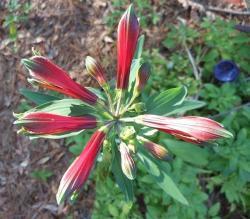
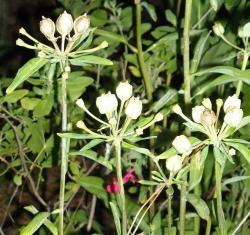
Alstroemeria - some may find it irritating. Working as a floral designer, I was warned that some people are sensitive to the sap/latex/goop in the stems and can get a skin irritation.
Alstroemeria has an abundance of common names, many of which start with the word Parrot: Parrot Alstroemeria, Parrot Flower, and Parrot Lily -- sometimes spelled Parrotlily. If you are feeling festive and happen to live in or near New Zealand, you can call them New Zealand Christmas Bell(s) or just plain Christmas Lily. The plant originated in South America, so I think that names such as Peruvian Lily, Inca Lily, or Lily of the Incas are very fitting (and a lot easier to pronounce than Tahuantinsuyu lily); or it could have been named Brazilian Lily or Chile Lily (which I would pronounce "chilly lily"). There is a compact variety called Princess Lily.
There are places where Alstroemeria is happy, as in my front garden. In some locations the Alstroemeria finds itself a little too happy and starts getting tagged as "invasive" -- in New South Wales, for example. I find articles that list this plant as a "backyard escapee" and as an "undesirable" plant, yet some people are willing to pay $30+ for the privilege of owning just one plant.
Alstroemeria can be grown from seed by patient people. First, soak the seeds for 24 hours, then place into a small cup of soil which is slightly damp, place the soil cup into an opened plastic bag at "room temperature" (for most people that is 68 - 85ºF) for about three weeks, then close the bag and refrigerate (36- 45Fº) for about four weeks. After the four weeks, remove each seed from the original growing medium. Plant 1/4 inch deep into small pots of mix (2 parts perlite/1 part sand is one choice). Keep the pots evenly moist at a temperature of 65- 75ºF. If all that hasn't tried your patience, here comes the good part: The seeds have a very low germination rate (20%) and do not all germinate at the same time. Some can show life in a month, or four months, or even six. (Winter sowers: Skip all those details, do your own thing with these seeds, and you will be quite successful.)
After all that time and effort, it can still take two years to see blooms, so some people prefer to plant bulbs/rhizomes/tubers, 4-5 inches deep, and keep them well mulched. These are not tropical bulbs and will get upset and go dormant if the weather is too hot or too dry. While the tubers can tolerate a fair amount of chilling if mulched well, gardeners in more northern climates will have to lift the tubers to overwinter them in damp sand. Use caution as the tubers and roots are brittle and can break easier than your mother-in-law's favorite crystal serving dish.
The reason I know anything at all about this plant is that I stopped at a yard sale in 2011 and said to the homeowner: "Oh, pretty plants. Are those for sale?" The woman spoke little English and called on her young daughter to interpret. Once the woman understood my question, she turned around and yelled something in Chinese really, really loud. I thought: Oh, no, I have offended her. From the garage an older woman came running, and she was carrying a shovel. My first thought was that I was about to be murdered in broad daylight and buried in the front garden, but no worries. The young girl explained to me that the flowers belonged to her grandmother and only grandma was allowed to dig in that garden bed. Whew! Took a minute for my heart rate to return to normal. So, for the agreed price of $5, I became the proud owner of... "those pretty red flowers I bought from the Chinese grandmother at the yard sale." Well, that got a little wordy even for me, so I started calling them NOID Chinese flowers, and after two years I learned their real name - Alstroemeria Psittacina aka Alstroemeria pulchella
Hardy in USDA zones 7-10; pH slightly acidic; 6.5 is good. Full sun in most places, but they should be given just a bit of shade in zones where strong sun could bleach the foliage. Moderate water and keep well mulched. The foliage grows between 6-12 inches high and looks like little green umbrellas ...
(oh, new word: umbrel); flower stalks 18-24 inches or taller. Attracts hummingbirds. Long-lasting as cut flowers.
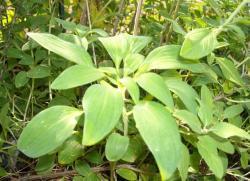
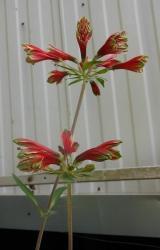
First warning: Put on your reading glasses and look up these words: "explosive dehiscence of seeds." Then you may remember to wear safety glasses when you collect the seed pods.
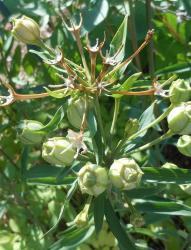
The seeds spew forth with quite a bit of velocity, seedlings appearing 5 - 7 feet away. They also fly into pockets, shoes, and empty flower pots and can spread to other areas of the garden (under an unused trailer).
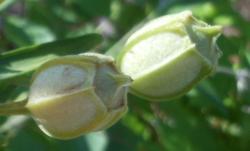

A whole bunch sprouted up in my neighbor's yard after I gave him some supposedly empty plastic pots.
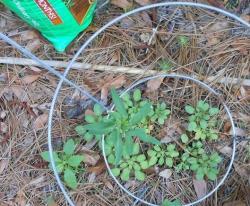
Second Warning: potentially invasive. I would suggest planting Alstroemeria if you love flowers and:
a) you are a diligent "dead-header";
b) you have lots of gardening friends who are willing to accept your extras;
c) you know how and are willing to use Roundup (even though it probably won't kill these determined plants).

That brings us back to the beginning. Some people find these wonderful plants to be irritating.
| Thread Title | Last Reply | Replies |
|---|---|---|
| Organza bags to the rescue! by greene | Jul 17, 2015 2:19 PM | 0 |
| Funny and factual by canadanna | May 21, 2014 6:35 PM | 6 |
| I love them for the hummingbirds by SongofJoy | May 21, 2014 5:16 AM | 0 |